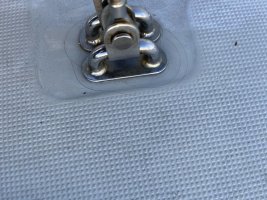Alan Gomes
Sustaining Partner
I just recently noticed these stress cracks underneath the U-bolts for the upper and forward lower shrouds. This is on the port side. There is an aluminum block underneath the deck, through which the U-bolts are bolted. Then, there is an adjustable tie rod that runs from the aluminum block to a heavily glassed-in attachment point lower on the hull.
In 2013, shortly after I purchased the boat, I had all of the chain plates removed for inspection, including the U-bolts, the aluminum block, and the tie rod. The U-bolts were suspect, so I had new ones custom fabricated by Garhauer. The aluminum block and tie rod were just fine. I also changed out all of the rigging.
It seems to me that there is a bit of a depression where the U-bolts penetrate the deck. This makes me wonder whether the rigger may have gotten a bit too enthusiastic when he tensioned the tie rod. But these cracks were a long time in coming. At any rate, as far as I can see, the deck would not take any of the shroud loads but the tie rod and lower hull attachment would--assuming the rod is tensioned properly. FWIW, I have not observed any change in the shroud tensions over the years, so that is holding well.
The starboard side does not show these cracks. That attachment is via a conventional chain plate bolted through a wooden bulkhead.
Have any of you seen cracks like this in connection with your shrouds supported by tie rods? Have you adjusted the tension on the tie rod? How do you know how to effect a proper adjustment? Any other thoughts on this?

In 2013, shortly after I purchased the boat, I had all of the chain plates removed for inspection, including the U-bolts, the aluminum block, and the tie rod. The U-bolts were suspect, so I had new ones custom fabricated by Garhauer. The aluminum block and tie rod were just fine. I also changed out all of the rigging.
It seems to me that there is a bit of a depression where the U-bolts penetrate the deck. This makes me wonder whether the rigger may have gotten a bit too enthusiastic when he tensioned the tie rod. But these cracks were a long time in coming. At any rate, as far as I can see, the deck would not take any of the shroud loads but the tie rod and lower hull attachment would--assuming the rod is tensioned properly. FWIW, I have not observed any change in the shroud tensions over the years, so that is holding well.
The starboard side does not show these cracks. That attachment is via a conventional chain plate bolted through a wooden bulkhead.
Have any of you seen cracks like this in connection with your shrouds supported by tie rods? Have you adjusted the tension on the tie rod? How do you know how to effect a proper adjustment? Any other thoughts on this?

